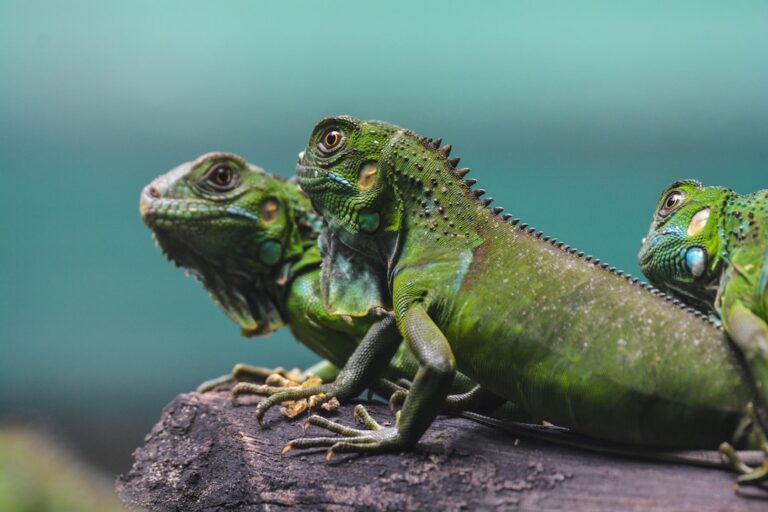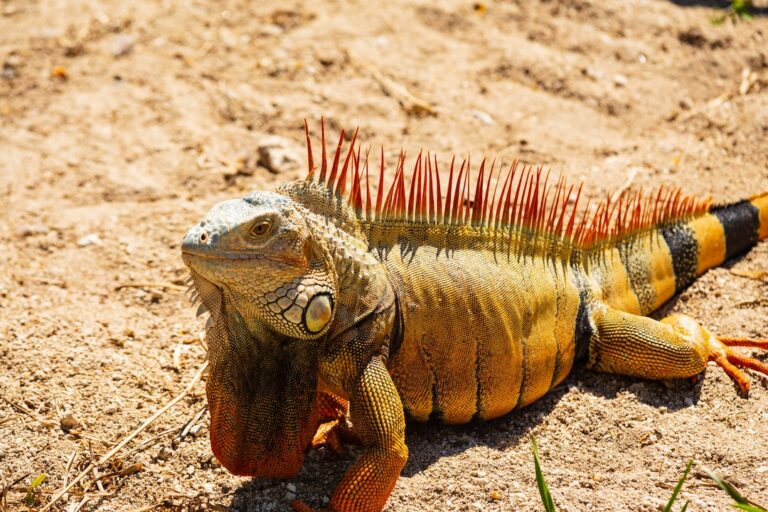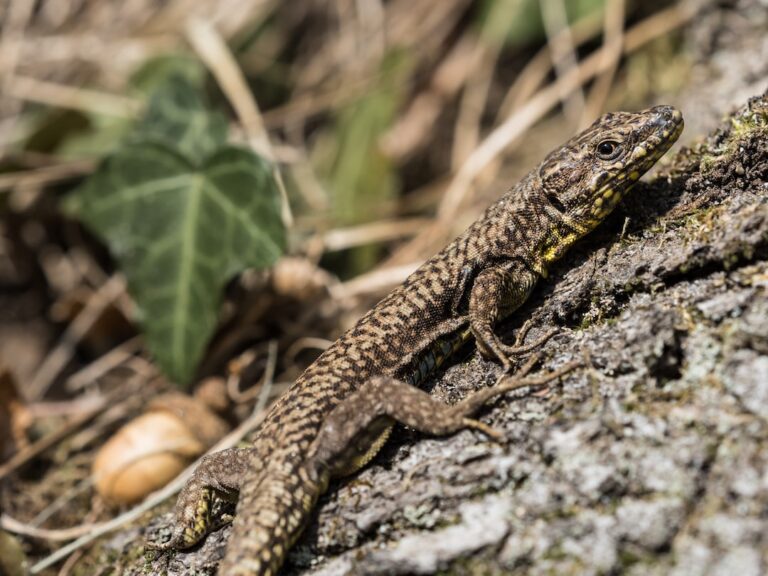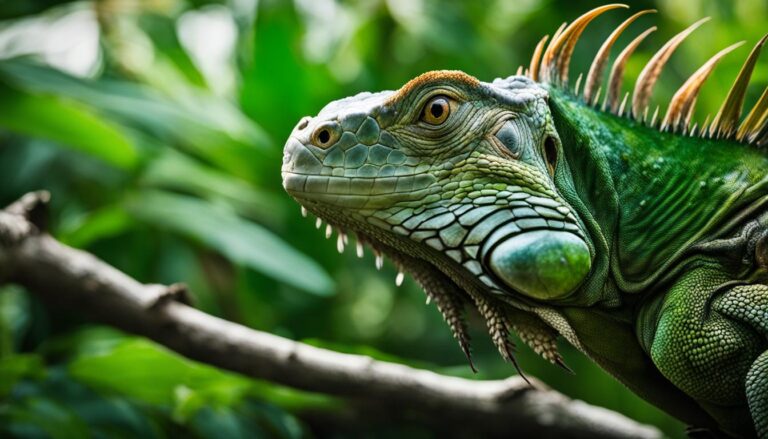Iguana Slumber Spots: Discover Where Iguanas Sleep
Welcome to our guide on where iguanas sleep! If you’ve ever wondered about the sleeping habits of these fascinating reptiles, you’ve come to the right place. Iguanas, with their vibrant colors and unique behaviors, have a distinct set of sleep patterns that contribute to their overall health and well-being.
In this article, we will explore the intriguing bedtime habits of iguanas and uncover the various spots they choose to rest. From treetops to ground burrows, we’ll delve into the factors that influence their sleeping preferences and provide valuable insights into their sleep patterns.
Table of Contents
Key Takeaways:
- Iguanas have specific sleep patterns that are crucial for recharging their energy levels and maintaining optimal health.
- They sleep in various locations, including trees, ground burrows, and man-made structures.
- Their choice of sleeping spot is influenced by factors such as security, temperature, and habitat.
- Iguanas exhibit unique sleep behaviors in response to seasonal changes in their environment.
- Creating a comfortable sleeping environment is important for captive iguanas.
Understanding Iguanas’ Sleep Necessities
In order to understand where iguanas sleep, it is important to first understand their sleep necessities. Sleep plays a crucial role in the overall health and well-being of iguanas. It allows them to recharge their energy levels, regulate their body temperature, and process food.
Importance of Sleep for Iguanas
Sleep is an essential biological process for iguanas. It supports their physical and mental functions, contributing to their overall health. During sleep, iguanas can replenish their energy reserves, repair cellular damage, and strengthen their immune system. Adequate sleep is particularly important for juvenile iguanas, as it promotes healthy growth and development.
Climbing to Rest: Iguanas in the Trees
Iguanas are arboreal creatures, meaning they are well-adapted to climbing and spending a significant amount of time in trees. When it comes to sleep, iguanas utilize their climbing abilities to find the perfect perch. Sleeping in trees provides several advantages for iguanas, including:
- Protection from ground-based predators
- Avoiding damp or wet ground
- Increased exposure to sunlight and warmer temperatures
Iguanas typically seek out stable branches with suitable characteristics for their sleeping spot. These characteristics include stability, warmth, and safety. By selecting the right branches, iguanas can ensure a comfortable and secure sleep environment.
The Perfect Perch: How Iguanas Choose Sleeping Branches
When choosing branches to sleep on, iguanas take into account various factors:
- Stability: Iguanas prefer branches that are sturdy and unlikely to break or sway during sleep.
- Warmth: As ectothermic animals, iguanas rely on external sources of heat to regulate their body temperature. They often choose branches that are exposed to sunlight or retain warmth.
- Safety: Iguanas prioritize safety while sleeping. They select branches that offer protection from potential predators and minimize the risk of falling.
By understanding these sleep necessities, iguana owners can create suitable sleeping environments that mimic their natural habitat, ensuring their pet’s comfort and well-being.
The Arboreal Haven: Tree Dwelling Behaviors
Iguanas are well-known for their arboreal habits, which involve their ability to climb and dwell in trees. These reptiles have evolved specific behaviors and physical characteristics that allow them to navigate tree branches with incredible agility. Their affinity for tree-dwelling not only provides them with a safe haven but also offers valuable insights into their preferred sleeping spots.
Where Do Iguanas Sleep: Treetops vs Ground Burrows
Iguanas have the unique ability to choose between two different sleeping locations – treetops and ground burrows. The choice of sleeping spot depends on several factors, including security, temperature, and habitat.
Opting for Elevation: Security Among the Branches
Sleeping in treetops provides iguanas with a sense of security. By choosing to sleep high above the ground, they can avoid potential dangers from ground-based predators. The height and specific branches they select provide a safe and secluded spot where they can rest undisturbed.
Escaping the Heat: Burrows as Sleeping Quarters
On the other hand, iguanas may also choose to burrow on the ground for their sleep. This option is particularly beneficial in hot climates or during the hottest hours of the day when they need to escape the intense heat. Ground burrows provide a cool and protected environment that allows them to regulate their body temperature while enjoying a restful slumber.
Habitats That Shape Iguana Slumber

Iguanas are found in a variety of habitats, including rainforests, deserts, and coastal areas. The specific habitat in which an iguana resides has a significant influence on their sleep spots. Different habitats offer unique resting places for iguanas, such as trees, burrows, or man-made structures. Exploring these habitats and their impact on iguana slumber provides invaluable insights into their sleeping habits.
The diverse range of habitats that iguanas inhabit offers them a wide array of sleeping options. For instance, iguanas in rainforests often find their ideal sleep spots high up in the tree canopy. Their strong climbing abilities enable them to access the safety and tranquility of the treetops, away from potential ground-based threats.
On the other hand, iguanas living in desert environments may seek refuge in underground burrows during their slumber. Burrows provide protection from extreme temperatures, offering a cooler and more stable environment for their sleep. These burrows are often dug deep into the ground, providing a secure hideaway.
Additionally, iguanas dwelling in urban areas adapt and utilize man-made structures as their sleeping spots. Buildings, walls, and even residential gardens often become alternative resting places for iguanas in these environments. The influence of human habitats on iguana slumber demonstrates their remarkable ability to adjust and thrive in diverse surroundings.
The table below summarizes the various habitats and corresponding sleep spots of iguanas:
| Habitat | Sleep Spot |
|---|---|
| Rainforest | Treetops |
| Desert | Burrows |
| Coastal | Man-made structures |
Understanding the influence of different habitats on iguana sleep spots allows us to appreciate their remarkable adaptability and provides valuable information for ensuring their well-being in captivity.
Adapting to Urban Environments: Iguanas Among Us
Iguanas, with their remarkable adaptability, have managed to find a place amidst the urban landscapes that humans have built. As human populations expand and encroach on their natural habitats, these fascinating reptiles have learned to make use of man-made structures as resting places. Buildings, walls, and even residential gardens have become alternative sleeping spots for iguanas in urban settings.
Navigating human habitats, however, comes with its own set of challenges for iguanas. They must strike a delicate balance between safety and comfort in these unfamiliar surroundings. While the structures offer new opportunities for resting, iguanas must remain vigilant and cautious to avoid potential dangers, such as encounters with humans or exposure to harmful substances in urban environments.
Man-made Structures as New Iguana Resting Places
Urban environments provide a variety of man-made structures that iguanas can utilize as resting places. Tall buildings often have ledges and alcoves where these reptiles can bask in the sun or find shelter. Walls and fences offer surfaces for them to climb and perch upon. Residential gardens, with their abundance of vegetation, can serve as attractive havens for iguanas seeking refuge.
Navigating Human Habitats: Balancing Safety and Comfort
Despite the availability of resting places, iguanas must navigate human habitats with caution. They instinctively seek out secluded spots that provide a sense of security, away from areas with high human activity. Iguanas often choose sleeping locations that are hidden or well-camouflaged, minimizing their visibility and reducing the risk of encountering potential threats.
When adapting to urban environments, iguanas also face challenges related to noise pollution, artificial lighting, and altered temperature patterns. These factors can disrupt their natural sleep cycles and affect their overall well-being. Nonetheless, iguanas have shown remarkable resilience in finding safety and comfort in urban areas, highlighting their ability to adapt to changing environments.
Rethinking Temperature: Iguanas’ Thermoregulatory Sleep
Temperature plays a crucial role in the sleep patterns of iguanas. As cold-blooded creatures, they rely on external heat sources to regulate their body temperature. During warmer parts of the day, iguanas are most active and seek cooler spots to rest during the hottest hours. Understanding their thermoregulatory needs provides insight into why they choose specific sleep spots and how temperature influences their sleep patterns.
During sleep, iguanas adjust their body temperature by moving to areas that provide the ideal thermal conditions. By finding cooler spots, they can lower their body temperature and enter a state of rest. This thermoregulatory behavior allows iguanas to conserve energy and maintain their overall health while sleeping.
The choice of sleep spot also depends on the external temperature and the iguana’s ability to adjust its body temperature accordingly. For example, if the temperature drops too low, iguanas may need to seek warmer environments to prevent excessive heat loss. On the other hand, during hot weather, they may look for shaded areas or shelter to avoid overheating.
By paying attention to the temperature preferences and thermoregulatory behaviors of iguanas during sleep, owners can ensure that their pet iguanas have a comfortable and conducive sleep environment. This includes providing suitable options for heat and shade, allowing the iguanas to regulate their body temperature effectively throughout their sleep cycle.
The Impact of Predators on Iguana Sleep Spots
Predators pose a constant threat to iguanas, even while they are peacefully sleeping. These fascinating reptiles have developed a range of survival strategies to protect themselves during their slumber. By carefully choosing their sleeping locations, iguanas can avoid ground-based threats and ensure their safety.
Elevated Slumber: Avoiding Ground Threats
Iguanas exhibit a remarkable ability to choose elevated sleeping spots in trees, which helps them avoid potential predators on the ground. By utilizing their climbing skills, they gain a natural advantage in finding secure and strategic resting places. These elevated slumber spots provide iguanas with a safe space where they can sleep undisturbed and out of reach from ground threats.
Burrowing for Life: When Predators Lurk Nearby
In situations where predators are known to be nearby, iguanas resort to a different survival technique – burrowing. By burrowing into the ground, these resourceful creatures create a protective shelter that keeps them concealed and inaccessible to potential threats. Burrowing serves as an effective defense mechanism, allowing iguanas to sleep soundly while staying out of harm’s way.
Understanding the impact of predators on iguana sleep spots highlights the importance of their choice of sleeping location. Whether they opt for elevated spots in trees or burrow underground, iguanas prioritize their safety and peace of mind during their slumber. These survival strategies ensure that they can rest undisturbed and wake up refreshed, ready to face the challenges of their environment.
Social Gatherings: Group Slumber Among Iguanas
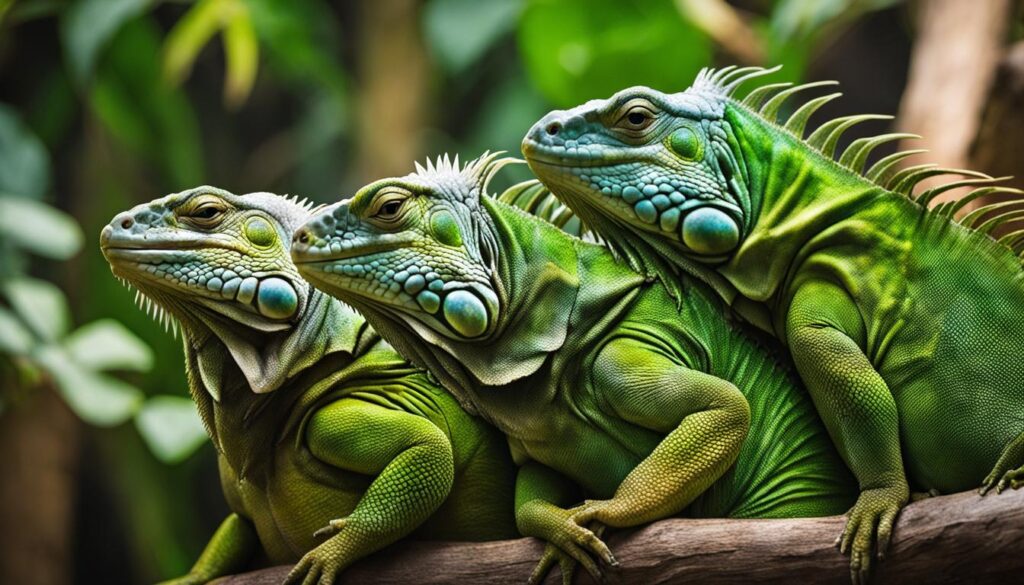
While iguanas are typically solitary creatures, there are instances when they engage in social sleeping. This behavior is observed during the mating season or in areas with high population densities. Sleeping in groups provides additional protection against predators and allows for better thermoregulation, ensuring the optimal temperature for each member of the group. Although not common for all iguana species, social sleeping is an intriguing behavior that highlights the social dynamics of these reptiles.
“Group sleeping among iguanas is a fascinating behavior that showcases their adaptability and social nature. By sleeping together, they not only gain protection but also bond and communicate with each other in subtle ways.”
Research has suggested that social sleeping among iguanas serves multiple purposes. Firstly, it enhances their collective safety, as the presence of multiple individuals deters potential predators. Additionally, by sharing body heat during sleep, iguanas can regulate their body temperature more efficiently, especially during cooler nights or in colder habitats. Group sleeping also allows for social interaction and communication, enabling iguanas to exchange information and strengthen social bonds.
| Advantages of Social Sleeping Among Iguanas |
|---|
| Enhanced protection against predators |
| Improved thermoregulation through shared body heat |
| Opportunity for social interaction and communication |
| Strengthening of social bonds within the group |
It’s important to note that social sleeping is not observed in all iguana species, and the frequency and extent of this behavior may vary. Factors such as habitat, population density, and environmental conditions influence the likelihood of iguanas choosing to sleep in groups. The intricacies of this behavior continue to be explored by researchers, shedding light on the social lives of these captivating reptiles.
Seasonal Adaptations: Iguanas’ Sleep Through Changing Climates
Iguanas are uniquely adapted to adjust their sleep behaviors in response to seasonal changes in their environment. These fascinating reptiles have developed dormancy and estivation as survival mechanisms to thrive in both cold and hot climates.
Surviving the Cold: Dormancy and Cold-Stunned States
In colder regions, when temperatures drop and food becomes scarce, iguanas enter a state of dormancy, similar to hibernation in mammals. During dormancy, their sleep patterns change, and they become less active to conserve energy. This period of reduced activity allows iguanas to withstand the cold and preserve their resources until favorable conditions return.
It’s important to note that extreme cold temperatures can sometimes lead to a phenomenon called cold-stunned states in iguanas. These states are a physiological response in which iguanas become immobile and seem as though they are sleeping or even dead. However, they are simply conserving energy and will regain normal function once the temperature rises.
Embracing the Heat: Estivation as a Survival Mechanism
In hotter regions, where temperatures soar and resources become limited, iguanas may enter a state of estivation. Estivation is a period of reduced activity and rest in response to extreme heat. During estivation, iguanas seek shelter in cool and shaded areas, reducing their activity levels to avoid overheating and dehydration. This adaptive behavior allows them to endure the harsh conditions of hot climates and conserve energy.
By adapting their sleep patterns to changes in climate, iguanas demonstrate their remarkable ability to survive and thrive in diverse environments. Whether it’s through dormancy in cold climates or estivation in hot climates, these seasonal sleep adaptations contribute to their overall well-being and long-term survival.
Creating a Cozy Niche for Your Captive Iguana
For those who keep iguanas as pets, it is crucial to provide them with a suitable sleep environment. Captive iguanas rely on their owners to create a cozy niche where they can rest comfortably. This includes providing a well-ventilated enclosure with branches or platforms for climbing and basking. Maintaining consistent temperature and light cycles, along with a quiet and undisturbed environment, contributes to their overall sleep quality and well-being.
Creating a comfortable sleep environment for your pet iguana requires careful consideration of their natural habitat and needs. One key aspect is providing a well-ventilated enclosure that mimics their natural habitat. This allows for proper airflow and ventilation, preventing the buildup of moisture and odors that can negatively impact your iguana’s sleep.
Another important factor to consider is the inclusion of branches or platforms within the enclosure. Iguanas are natural climbers and providing them with opportunities for climbing and basking helps create a sense of security and fulfillment. These elevated perches can serve as their preferred sleeping spots, allowing them to rest comfortably off the ground.
Consistency is key when it comes to temperature and light cycles. Iguanas require specific temperature ranges to regulate their body temperature and sleep comfortably. Providing a basking area with suitable heat sources, such as heat bulbs or pads, allows your iguana to thermoregulate and achieve their desired sleep temperature. Additionally, maintaining a consistent light cycle, simulating their natural day-night rhythm, helps establish a healthy sleep pattern.
Lastly, providing a quiet and undisturbed environment is crucial for your pet iguana’s sleep quality. Keeping noise and disturbances to a minimum ensures that they can rest peacefully without unnecessary interruptions. This can include placing their enclosure in a calm area of your home and avoiding loud noises or sudden changes in their surroundings.
By creating a cozy sleep environment for your captive iguana, you are contributing to their overall health and well-being. Remember to consider their natural habitat, provide suitable climbing and basking options, maintain consistent temperature and light cycles, and create a quiet and undisturbed space for them to rest. With these considerations in mind, you can ensure that your pet iguana enjoys a comfortable and restful sleep.
Iguanas’ Sleep and Their Connection to Overall Health
Linking Sleep Quality with Iguana Wellness
Sleep quality plays a vital role in the overall health and wellness of iguanas. Just like humans, iguanas need a good night’s sleep to maintain their well-being. Quality sleep is closely linked to various aspects of iguana health, including immune function, digestion, and overall vitality.
During sleep, iguanas recharge their energy levels and allow their bodies to undergo essential processes such as tissue repair and growth. Adequate sleep supports their immune system, making them more resilient to diseases and infections.
Additionally, sleep directly affects iguanas’ digestive health. Proper sleep allows them to efficiently process food and absorb nutrients, promoting a healthy metabolism and optimal nutrient utilization.
Moreover, sleep quality can impact an iguana’s overall vitality and well-being. Restful sleep helps iguanas maintain optimal physical and mental conditions, enabling them to thrive in their respective environments.
Therefore, prioritizing sleep quality is crucial for owners to ensure the well-being of their iguanas. By providing a suitable sleep environment and addressing any potential sleep-related issues, owners can promote their iguanas’ overall health and vitality.
Observing Sleep Patterns for Health Monitoring
Monitoring iguana sleep patterns is an essential aspect of their overall health care. By observing and understanding their sleep behaviors, owners can gain valuable insights into their iguanas’ well-being.
Regularly observing sleep patterns allows owners to identify any changes or abnormalities that may indicate underlying health concerns. Sudden alterations in sleep duration, frequency, or quality could be signs of illness, stress, or environmental factors affecting the iguana’s sleep habits.
Owners can track their iguanas’ sleep patterns by noting the duration and quality of sleep on a daily basis. This information can be recorded in a sleep journal, providing a valuable reference for monitoring changes over time.
Furthermore, owners should pay attention to other factors that may affect their iguanas’ sleep, such as temperature, humidity, lighting, noise levels, and the presence of predators or disturbances in their environment.
Regular veterinarian check-ups can also help assess an iguana’s sleep patterns and overall health. Veterinarians can provide guidance on proper sleep care for iguanas and offer advice specific to each individual’s needs.
Monitoring iguana sleep patterns and addressing any concerns promptly can contribute to their long-term health and well-being. By giving proper attention and care to their sleep, owners can support the overall wellness of their iguana companions.
Conclusion
In conclusion, understanding where iguanas sleep is crucial for their overall well-being. These fascinating reptiles carefully select their sleep spots based on safety, comfort, and temperature preferences. Whether they choose treetops, ground burrows, or man-made structures, iguanas have specific needs for a restful slumber.
Respecting their natural sleep patterns and providing suitable sleeping environments is essential for their health and happiness. For those who keep iguanas as pets, creating a cozy niche with branches or platforms for climbing and basking is important. Maintaining consistent temperature and light cycles, along with a quiet and undisturbed environment, contributes to their sleep quality.
Monitoring iguanas’ sleep patterns can offer valuable insights into their overall well-being. Quality sleep is linked to their immune function, digestion, and vitality. By observing changes in their sleep patterns, owners can ensure their iguanas are in good health and address any potential sleep-related issues.
By understanding where iguanas prefer to sleep and providing them with suitable sleeping environments, we can help these remarkable reptiles enjoy a restful slumber, promoting their health and happiness.
FAQ
What are iguanas’ sleep necessities?
Sleep plays a crucial role in the overall health and well-being of iguanas. It allows them to recharge their energy levels, regulate their body temperature, and process food.
Do iguanas sleep in trees?
Yes, iguanas are known to sleep in trees, utilizing their climbing abilities to find the perfect perch.
How do iguanas choose sleeping branches?
Iguanas select branches based on factors such as stability, warmth, and safety.
Do iguanas sleep in treetops or ground burrows?
Iguanas have the ability to choose between sleeping in treetops or finding shelter on the ground in burrows. The choice depends on factors such as security, temperature, and habitat.
Where do iguanas sleep in urban environments?
Iguanas in urban settings may make use of man-made structures such as buildings, walls, and residential gardens as alternative sleeping spots.
How does temperature affect iguana sleep patterns?
Temperature plays a crucial role in the sleep patterns of iguanas. They are most active during warmer periods of the day and seek cooler spots to rest during the hottest hours.
How do iguanas protect themselves from predators while sleeping?
Iguanas choose elevated sleeping spots in trees to avoid ground-based threats. They may also burrow into the ground for protection when predators are nearby.
Do iguanas sleep alone or in groups?
While iguanas are typically solitary creatures, they may opt for social sleeping during the mating season or in areas with high population densities.
How do iguanas adapt their sleep patterns to changing climates?
In cold regions, iguanas enter a state of dormancy to conserve energy. In hotter regions, they may enter a state of estivation to survive extreme heat.
How can I provide a suitable sleep environment for my pet iguana?
For pet iguanas, it is crucial to provide a well-ventilated enclosure with branches or platforms for climbing and basking. Maintaining consistent temperature and light cycles, along with a quiet and undisturbed environment, is important for their sleep quality and well-being.
How does sleep quality impact iguana health?
Quality sleep is linked to iguanas’ immune function, digestion, and overall vitality. Monitoring their sleep patterns can provide insights into their well-being.
What is the connection between observing sleep patterns and monitoring iguana health?
By paying attention to sleep quality and observing any changes in their sleep patterns, owners can ensure their iguanas are in good health and address any potential sleep-related issues.
What are some concluding thoughts on iguana sleep spots?
Understanding where iguanas sleep is essential for their overall well-being. By respecting their natural sleep patterns and providing suitable sleeping environments, we can ensure that our iguana friends enjoy a restful slumber, promoting their health and happiness.


